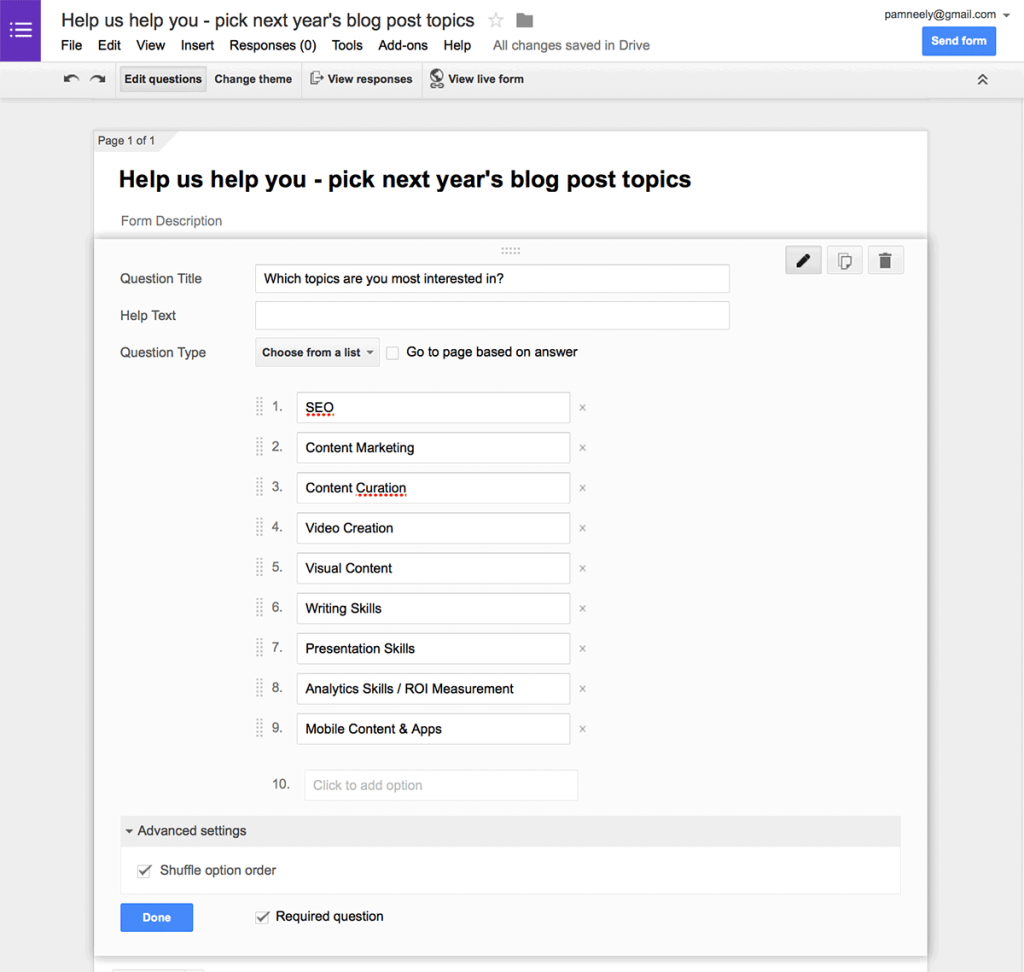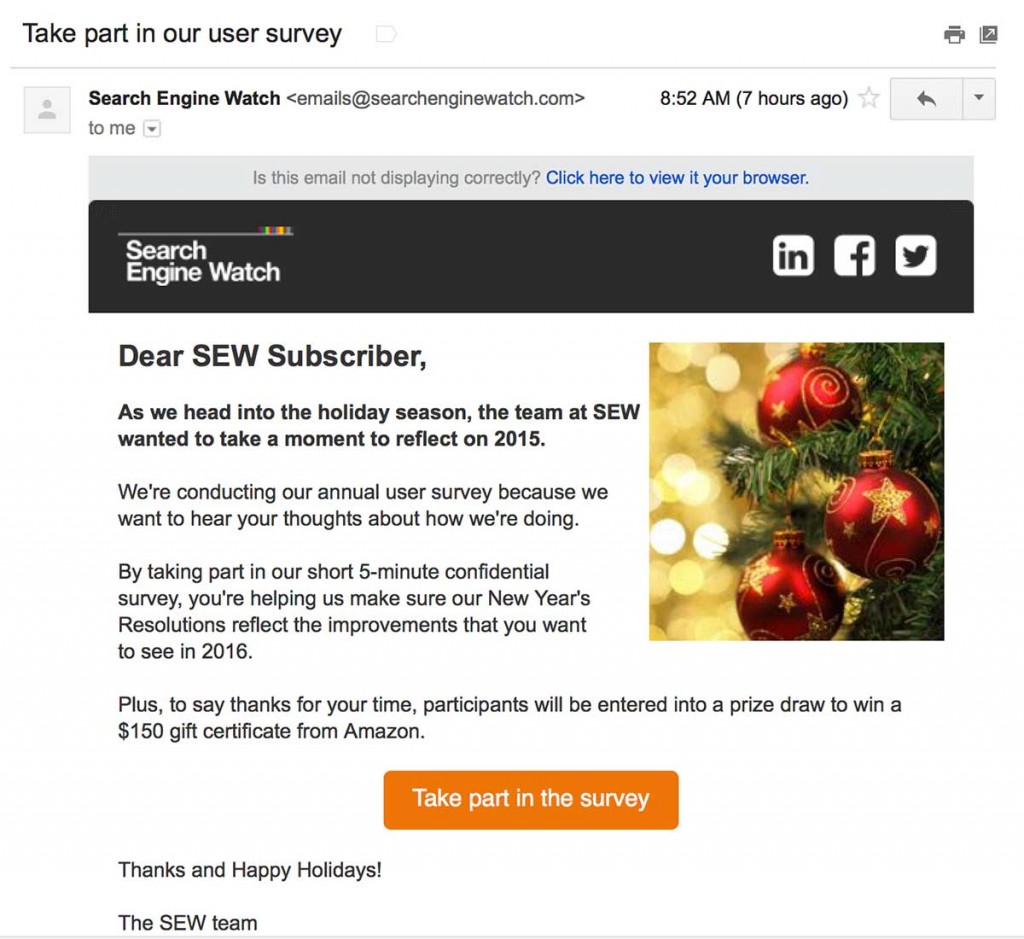
It’s that time of year again… all the blog posts about predictions and trends are out. Everybody (me included) is buffing up their crystal ball.
That’s all well and good. But if I had a choice about which future to see, I’m not sure I’d go with predictions about digital marketing trends. I might not even want to know when the next Penguin update will roll out.
I’d rather know what my audience will want in 2016 – and what they want right now.
I’d like to get in their heads.
So though my crystal ball is busted, I don’t really even need one. There’s a proven, simple tool to tell me what my audience wants to know.
It’s a survey. Typically a survey sent to your email list, but possibly an advertised survey, or a survey promoted on your website. Properly practiced, surveys can reveal secrets even your audience might not know about themselves. And if you know how to scry the results, it can give you some killer content marketing ideas, too. No crystal ball required.
Want to learn the craft? Here’s a crash course in how to use surveys for content marketing and find out what your audience wants to know.
First step: Define how you’re going to apply what you learn.
DO NOT SKIP THIS. Sorry to yell at you, but this aspect of surveys gets skipped over way too often. And it is the most important part. That’s why it comes first.
If you don’t define what you need to know ahead of time, you risk ending up with no actionable data. You might turn up some “interesting” data. But none of it will point you toward any specific course of action.
There’s another hazard. If you don’t put much thought into what you really need to know, you may end up asking survey questions you’ve already got answers for.
Where are those answers? In your analytics data. For example, don’t ask people what their favorite piece of content was for 2015. You should already know – just check your analytics data for which piece (or pieces) of content got the most shares, page visits and comments.
If you’ve got a lot of analytics data that you haven’t quite sorted out, consider a content audit before you dive into a survey. It could save you a lot of time.
Either way, please think hard about:
- What you need to know
- Which information only a survey can give you
- How you want to apply what you learn
Know the answers to those questions BEFORE you write the survey. Before you pick your survey application. Before you do anything else.
Second step: Be able to send a survey.
Almost all email service providers let you send out surveys now. MailChimp, Constant Contact, GetResponse, VerticalResponse, and iContact’s standard accounts all let you survey your subscribers.
I was surprised to learn AWeber does not offer surveys. And while Campaign Monitor does, you have to pay extra.
If you’re with an email provider that doesn’t offer surveys, you’re not out of luck. You can send a survey to your email list via Google Forms, Survey Monkey or SurveyGizmo.
Third step: Write your survey questions.
If you did your homework at the beginning, writing survey questions should be easy. Just avoid the classic survey question mistakes:
- Don’t ask too many questions.
Long surveys are a drag. They also get extremely low completion rates. Try to limit yourself to 3-5 questions, especially if you’re concerned about not getting enough survey replies to have actionable results.
If you’re got a huge audience to survey, you might be able to get away with up to ten survey questions. Any more than that becomes tedious for the survey respondents. Remember: You aren’t the only marketer asking people to complete a survey. I get 2-3 survey requests every day.
Some of the most effective surveys are just three questions long. The marketer Glen Livingston devised a great survey with just three questions. They are:
- What’s your most pressing question about X (your niche, industry, topic)?
- How hard has it been to find information about that question? Rated from 1 to 5 for difficulty.
- What prompted you to sit down today?
Those questions artfully reveal what motivates your audience and what they struggle with. They can help you craft killer content. Those questions also reveal which content topics your competitors have missed.
- Don’t ask leading questions.
Remove all bias from your questions. For example, asking “Which one of our products do you like best?” assumes every survey respondent likes your products.
- Be careful how you break out groups.
This is basically a bias problem, but more subtle. Let’s say you’re asking your audience how old they are. The answers are:
- under 16
- 17-25
- 26-35
- 36 or older
You’ve assumed most of your audience is under 36. What if you’re wrong, and half your audience is over 36? You will know that after the survey (some progress) but you won’t know how many people over 50 are there. That’s a lost opportunity.
- Limit open-ended questions.
I like at least one open-ended question per survey. They can reveal things I’d never know to ask. But be careful: Getting actionable data from open-ended (ie, “qualitative” or text-based answers) questions can take a lot of time. Even worse, some survey respondents resist answering these types of questions – they’re harder to complete than simple checkboxes.
Fourth step: You need an audience to send the survey to.
If you’re sending this survey to email subscribers, you’re going to need…
email subscribers.
Duh, right? But hold on. You need enough email subscribers to get reliable results.
How many email subscribers you need depends on how responsive your list is and how many people you can get to complete the survey. If you’ve got, say 1,000 email subscribers, here’s how it might shake out:
3% of your 1,000 subscribers click on the email = 30 people see the survey
50% who see the survey finish it = 15 people finish the survey
Uh-oh. That won’t work. It’s not enough completed surveys. You need at least 30 surveys to even get a guestimate of what your audience wants. 100 is better, especially if you want statistically valid results. (And you do.)
What now?
First, mail the survey out to your list again, but at a different time. Change the subject line. That should get you a few more completed surveys.
Second, offer something in exchange for completing the survey. Free ebooks are okay, but not great. A chance to win one of three $100 Amazon gift certificates might work.
Let’s say those two tactics double your responses. Now you’ve got 30 completed surveys. Better, but still iffy.
Keep going: Beat the bushes via social media to reach your audience there. And maybe you have to buy a bit of Facebook advertising to reach your goal. Maybe you have to put a couple of promotions on your website.
Hopefully, all that work nets you 30 more completed surveys, for a total of 60. That’s just enough to see a pattern. It’s better to get 100-400 completed surveys, but aim for least 50.
You can also buy completed surveys. My two favorite places for that are SurveyMonkey’s Audience program and Google’s consumer surveys. It’s possible to get surveys completed for as little as $1 each, depending on the audience you want to reach and how complex your survey is.
Or you can advertise. Come up with a great offer (a gift certificate, ebook, or a coupon). Use that as the enticement to complete the survey. Just be careful: Depending on the advertising costs, you might save money just buying responses directly from SurveyMonkey or Google.
Finally, you make the ask.
This is where you sell the survey to your audience. If you’re emailing your list about the survey, you’ll write a killer email enticing them to fill out your survey. If you’re advertising to get survey results (or putting a promo on your site), you’ll need some ad copy.
Here’s an example of an email I got recently, asking me to complete a survey:
Notice a few things about this:
- It’s short
- It explains what’s in it for them – the Amazon certificate, plus the promise of better content
- It says how long it will take to complete the survey
That’s all you need to say in a survey invite. Let them spend their time on the survey, not reading the email about it.
Conclusion
Surveys are a great way to learn more about your audience. With carefully-crafted questions, you can find out what they aspire to, what they worry about, and what information they’re having a hard time finding. All that can be directly channeled into your content marketing strategy, and hopefully into your editorial calendar.
Back to you
Have you surveyed your audience lately? How did it go? What problems did you run into, or was it a gigantic success? Leave a comment and tell us how it went.
And if you’d like to know how you can start blogging consistently in 30 minutes a day or less, read our eBook!
Image by The Bees.




